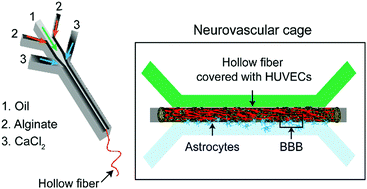Microfluidic approach for the fabrication of cell-laden hollow fibers for endothelial barrier research†
Abstract
This study reports an advanced approach to effectively generate hollow fibers in a triple-flow polydimethylsiloxane (PDMS) microfluidic device based on the gelation of alginate induced with CaCl2 inside a coaxial flow system. Two PDMS replicas with a semi-cylindrical microchannel were assembled to obtain a complete microchannel with a circular cross-section, which allowed the formation of mild and continuous coaxial flows for the fabrication of hollow fibers without employing complex glass microcapillaries. Mineral oil was introduced into the central flow to serve as an inert space inside the Ca–alginate wall. This was used to maintain the consistent formation of the hollow core of the microfiber and to easily transport fluid through the lumen structure in subsequent applications. The hollow fibers exhibited characteristics such as flexibility while showing robust mechanical strength, high permeability, and biocompatibility, and were used as scaffolds for the attachment and proliferation of human umbilical vein endothelial cells (HUVECs) to mimic a blood vessel. The fully covered HUVEC fibers were further integrated into a neurovascular system and co-cultured with astrocytes forming an on-chip blood brain barrier (BBB) platform. The use of this neurovascular model for drug testing will pave the way for developing or synthesizing a new drug that can cross the BBB in the human brain.



 Please wait while we load your content...
Please wait while we load your content...